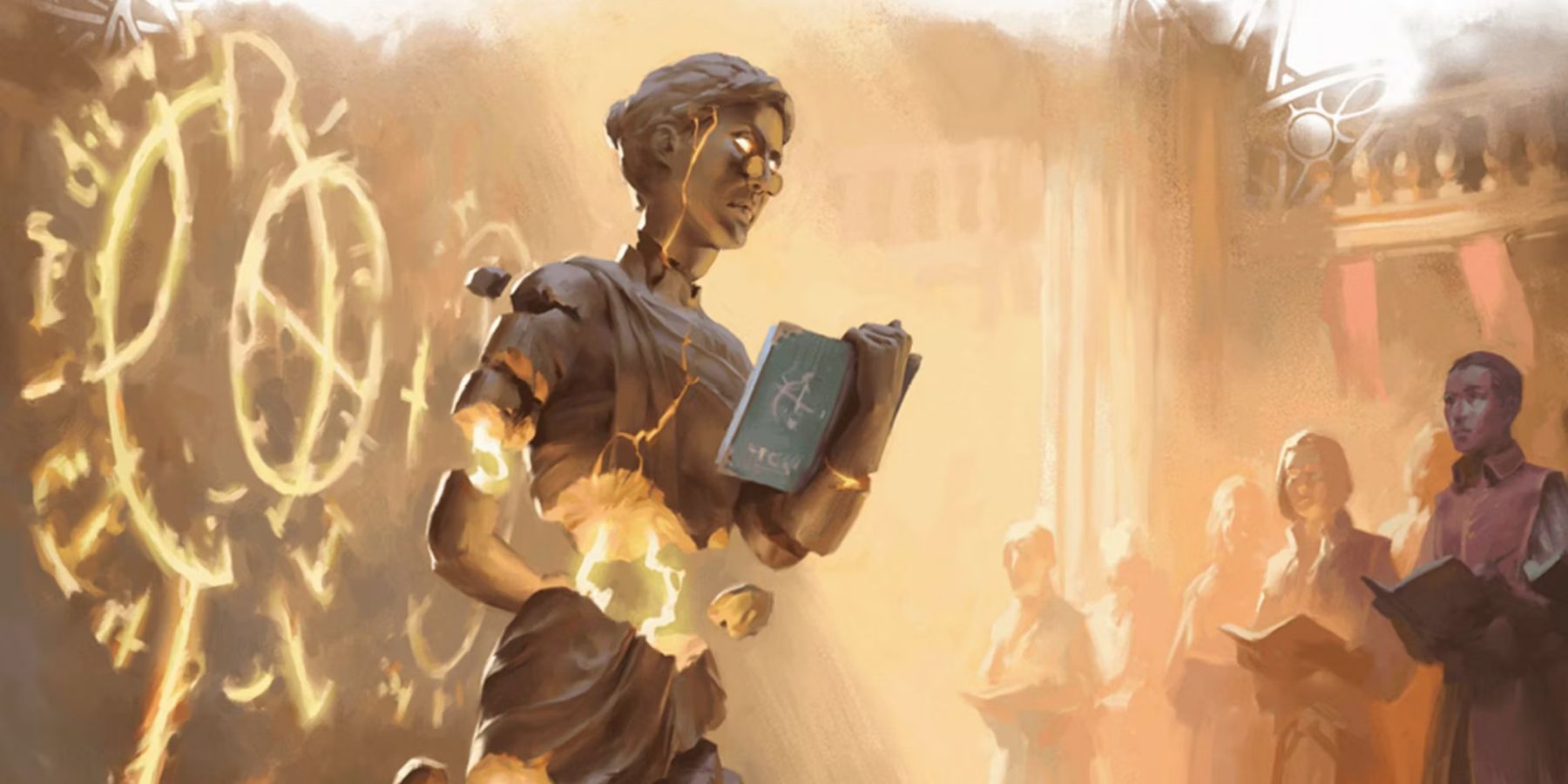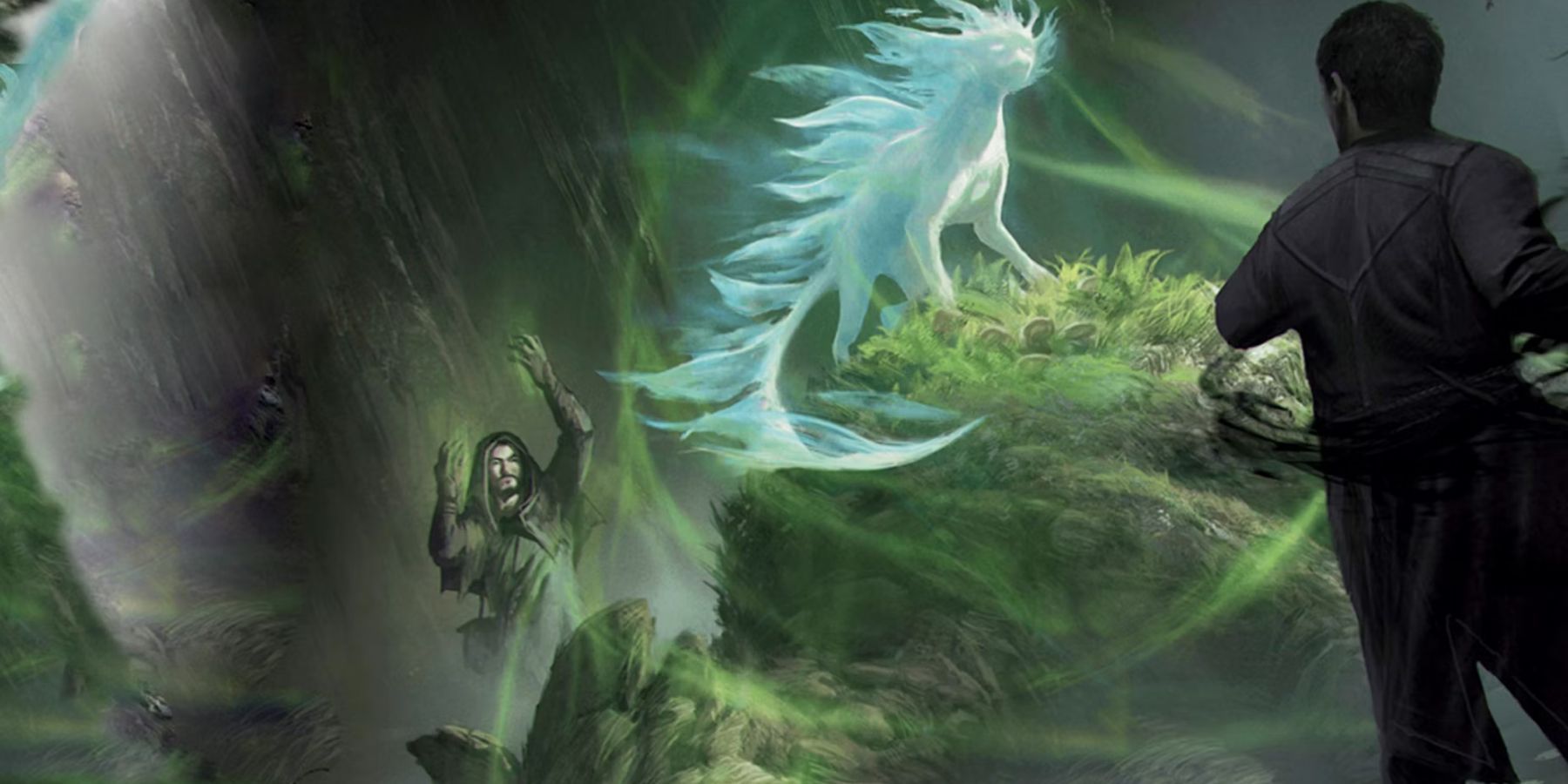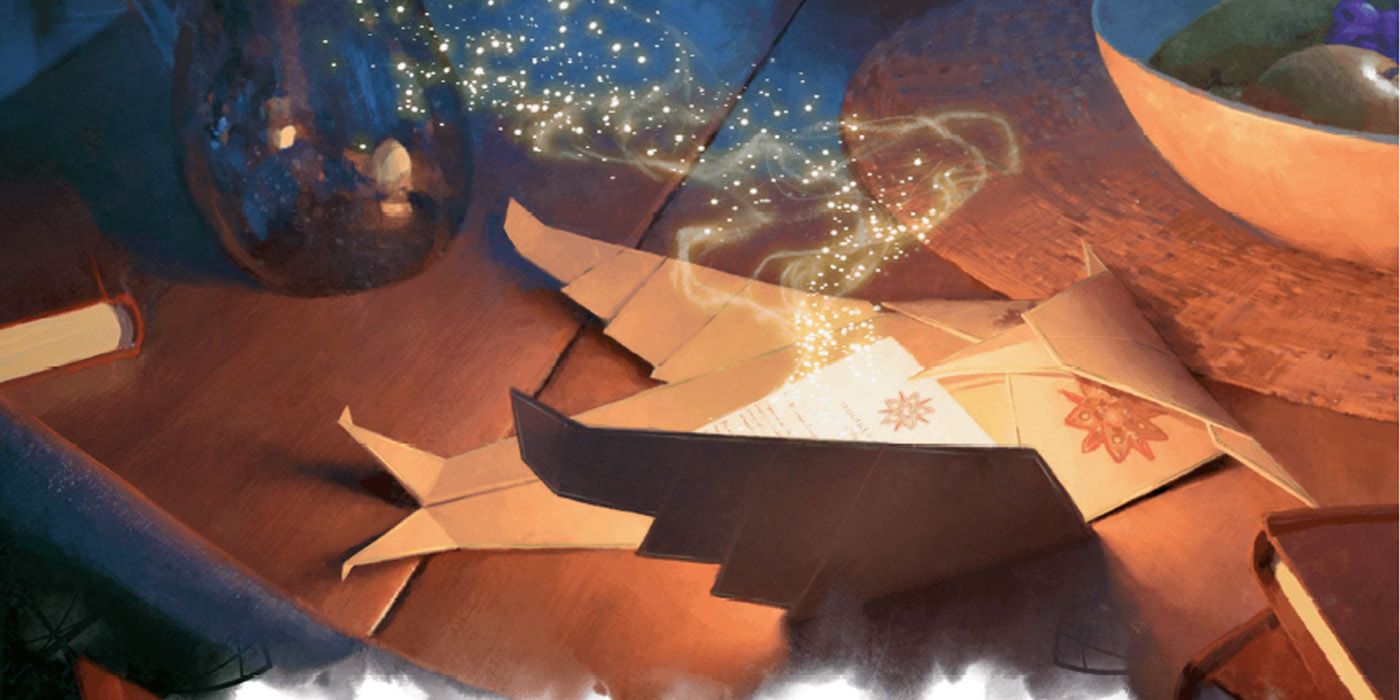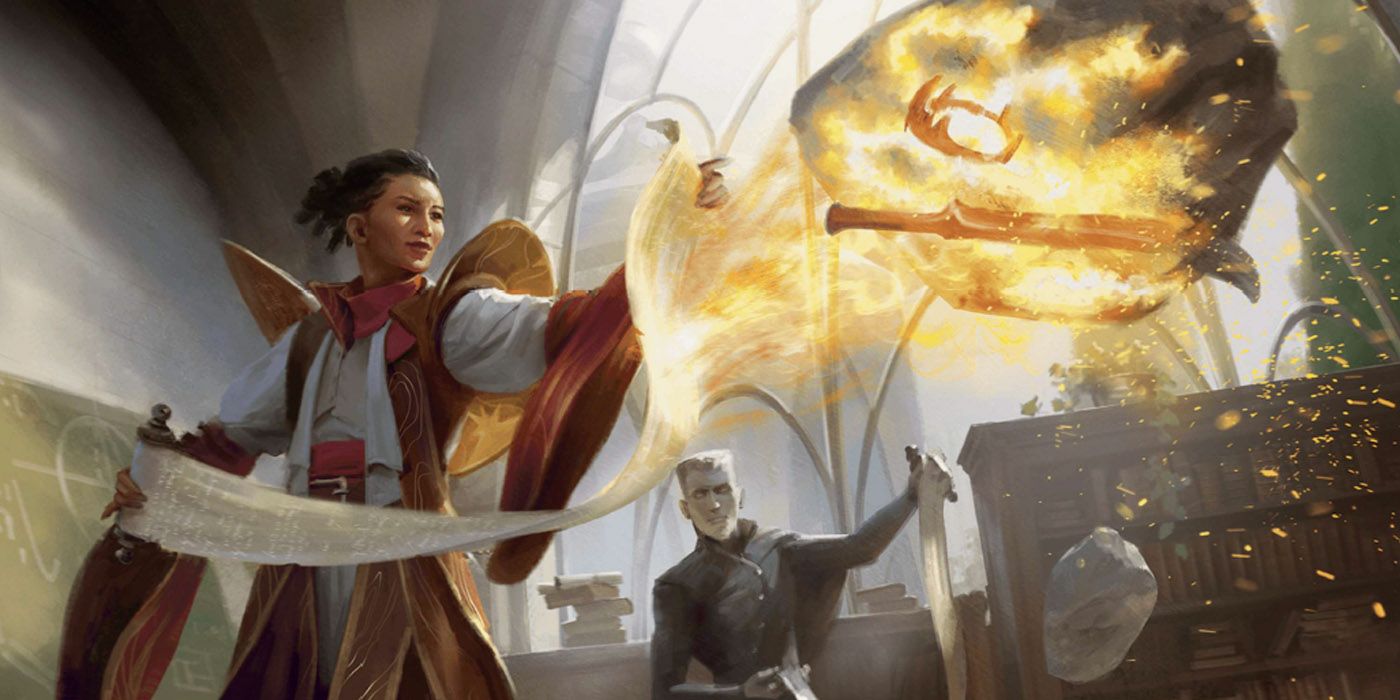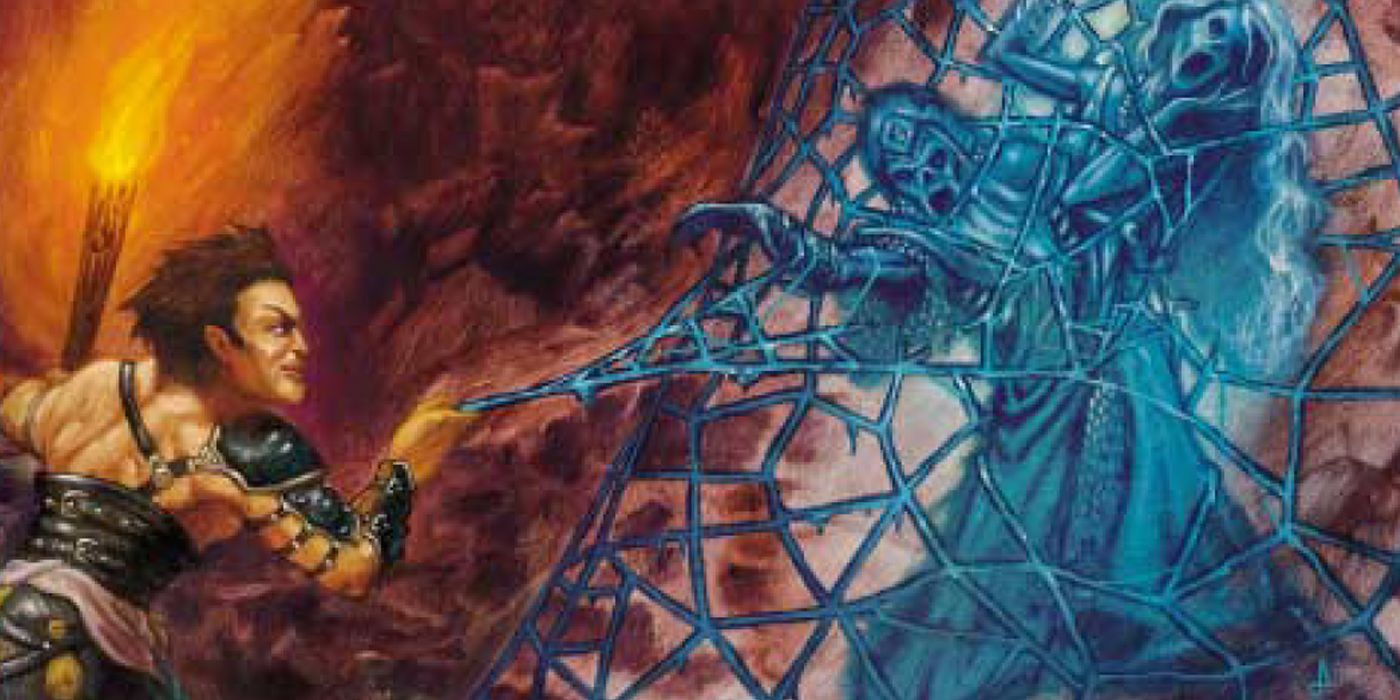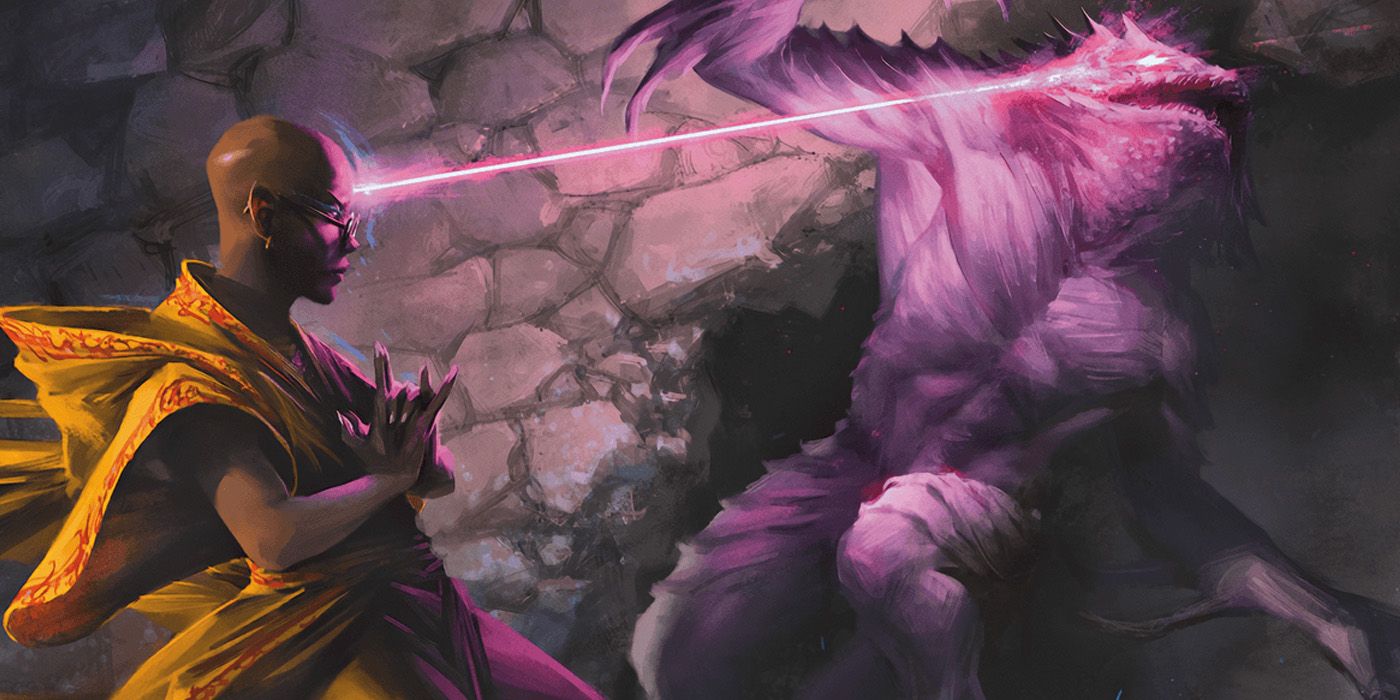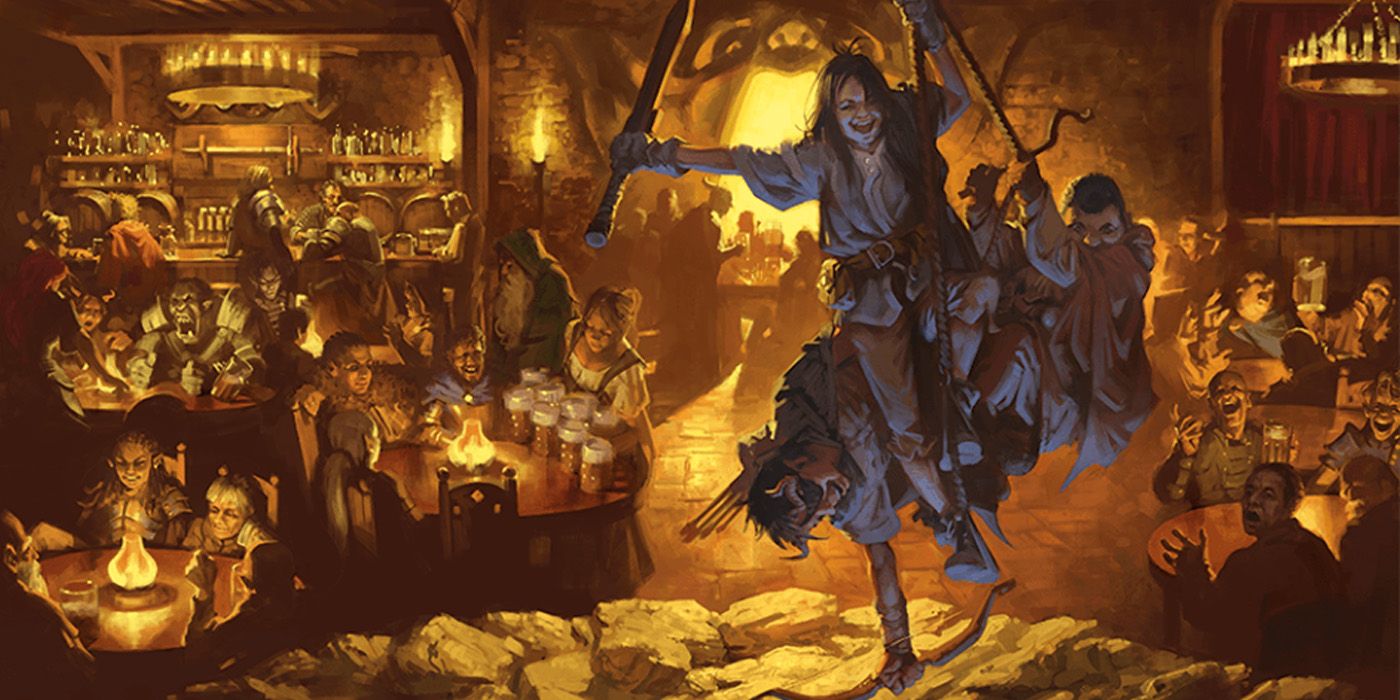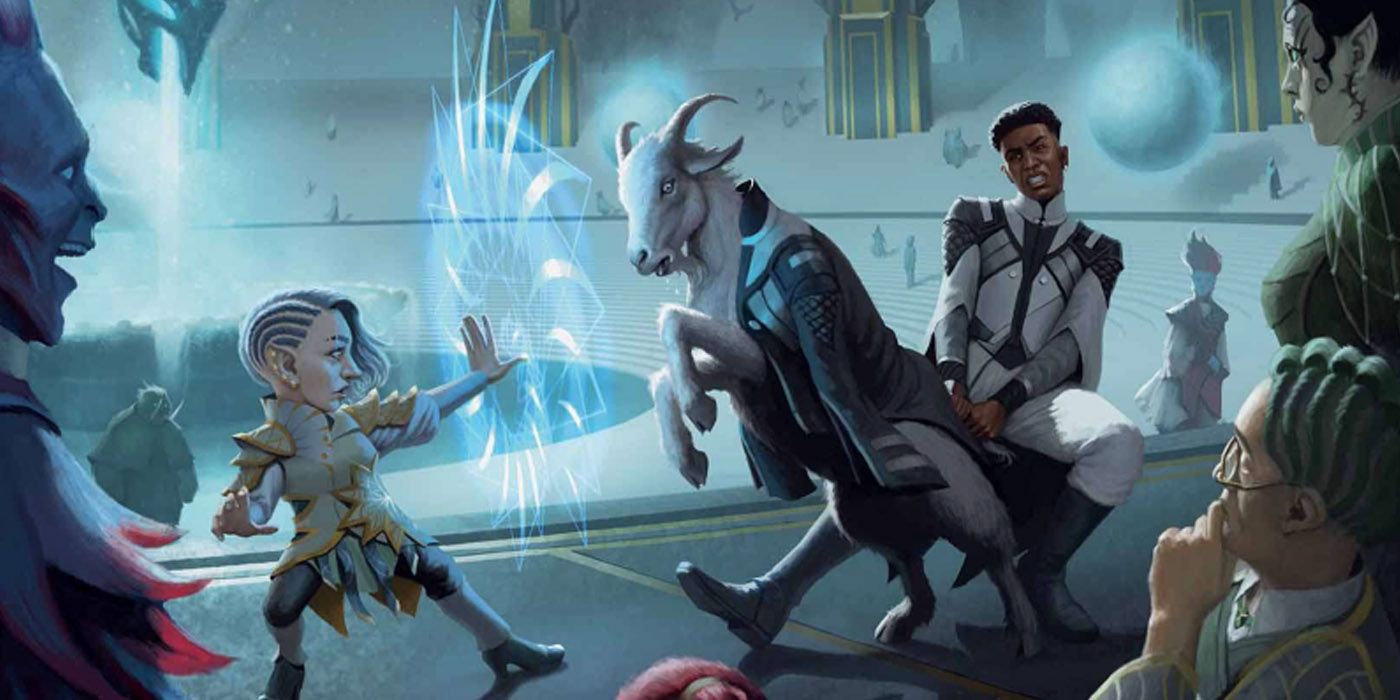Highlights
- Spellcasters in D&D 5e can use Encode Thoughts to manifest their thoughts into tangible strings, allowing them to communicate ideas or memories.
- Distort Value is a spell that allows spellcasters to manipulate the perceived value of an object, which can be useful for negotiating or deceiving others.
- Wall of Force is a powerful defensive spell that creates an impenetrable barrier, making it ideal for trapping or separating dangerous enemies.
Fans of Dungeons & Dragons 5e know their spells can spell the difference between successful encounters and a grim demise. After all, spells devastate entire battlefields, charm and amaze others, or even make difficult situations much easier to bear with. Moreover, adventuring parties need spellcasters to tap into their magical prowess to provide a wealth of advantages to their comrades.

D&D: 10 Most Common Problems During A Campaign (& How To Solve Them)
While there isn’t a setlist of issues that can be encountered, some are more common than others.
However, characters should start to consider using their spell list to achieve more creative effects. Players interested in transforming their spellcasting experience in D&D 5e can capitalize on certain spells to achieve a wide variety of feats that can greatly benefit their parties.
Updated on April 27, 2024, by Rhenn Taguiam: With 2024 marking the release of One D&D and the upgraded Player’s Handbook for Dungeons & Dragons 5th Edition, fans of the acclaimed TTRPG might be curious as to the kind of new adventures they could do with the changes to mechanics about to be put in place. In the case of Spellcasters, new rules regarding Spells may change the dynamics they have with the game - meaning players may have to alter their arsenal to more accurately follow the change in rulesets. Thankfully, Spellcasters can have reliable Spells in their arsenal that won’t necessarily break the rules in order to be helpful. Some of these Spells include minor illusory effects, the ability to summon a spirit beast, the ability to summon the undead, and even the go-to attack of some mages.
30 Thaumaturgy
Transmutation Cantrip
Casting Time | 1 Action |
|---|---|
Range | 30 Feet |
Target | Effect-dependent |
Components | Verbal |
Duration | Up to 1 Minute |
Classes | Cleric |
Essentially the Cleric’s version of Prestidigitation, Thaumaturgy (Transmutation Cantrip) allows the Cleric to use a bit of their holy connection to create “effects” that the faithful could otherwise attribute to the divine. These effects are minor wonders that can range from booming voices, controlling existing fire, causing harmless tremors, generating an instantaneous sound, suddenly manipulating a door or a window, and altering their eyes’ appearance.
Clerics can use up to three of these effects at a time for its one-minute duration, and they need an individual Action to be dismissed. Compared to Prestidigitation, Thaumaturgy can be quite limited in its uses. However, a Cleric who needs to be a temporary face of the party may have use for Thaumaturgy’s effects.
When To Use Thaumaturgy
Considering the limited uses of Thaumaturgy, a Cleric won’t have much use for its effects in combat. However, Thaumaturgy can be more creatively used in the context of conversations and outside dungeon affairs. A Cleric can use this to convert the unfaithful or even minor enemies to their cause, while it can also scare other people into submission. Alternatively, a Cleric in hiding can use its effects to accompany a Bard or a party’s face in order to improve their performance during a conversation.
29 Prestidigitation
Transmutation Cantrip
Casting Time | 1 Action |
|---|---|
Range | 10 Feet |
Target | Effect-dependent |
Components | Verbal, Somatic |
Duration | Up to 1 Hour |
Classes | Bard, Sorcerer, Warlock, Wizard |
Whereas illusionists have their neat bag of tricks, Spellcasters in Dungeons & Dragons gameplay have Prestidigitation (Transmutation Cantrip) as a nifty way of demonstrating their magical prowess without necessarily giving away their secrets. When activated, a Spellcaster can extend their gift of the arcane to create mundane effects: an instantaneous and harmless sensory effect, manipulating a source of fire, cleaning or dirtying an object, manipulating the temperature of an object, generating a mark in an object, or creating a non-magical illusory hand-sized image.
Up to three of these effects can be cast at once, each lasting for an hour, and can be dismissed as an Action. Despite its rather mundane effects, Prestidigitation can be a party’s backup illusory Spell against NPCs and other easily gullible citizens.
When To Use Prestidigitation
Despite its rather simple effects, players can take advantage of Prestidigitation if they want to confuse or convince opponents from a sensory standpoint. A pretend doctor or scientist could use Prestidigitation to cause sensory effects that can convince a patient or even a villain of something being in effect. Likewise, Prestidigitation can be used to distract an audience for other things to take place, such as a heist or sneaking into a location.
28 Summon Beast
2nd-Level Conjuration
Casting Time | 1 Action |
|---|---|
Range | 90 Feet |
Target | Unoccupied Space |
Components | Verbal, Somatic, Material (200gp worth of fishtail, tuft of fur, and a feather inside a gilded acorn) |
Duration | 1 Hour (Concentration) |
Classes | Druid, Ranger |
Debuting in Tasha’s Cauldron of Everything is Summon Beast (2nd-Level Conjuration), a relatively low-level summoning Spell that can provide Spellcasters with many companion options that can greatly augment their party. Its hour-long duration with environmental and Spell Level-dependent bonuses allows players to have beasts that breathe underwater (Water Breathing, Water Spirit), can fly away without provoking Opportunity Attacks (Flyby, Air Spirit), or have Advantage when attacking within melee range of the caster or their ally (Pack Tactics, Land and Water Spirit).
This ability to “create” a companion based on preference can encourage players to get more creative regarding timing and maximizing their summons. The hour-long duration can also last an encounter or two and may incentivize the usage of higher-level Spell Slots for a guaranteed stronger ally instead of a one-time powerful Spell.
When To Use Summon Beast
The best way to use Summon Beast is ideally in conjunction with the party’s melee attackers. This allows Summon Beast to take full advantage of its Pack Tactics (as Land or Water Spirits), especially its Multiattack should players cast it at a higher-level Spell Slot. Its potential to have a relatively high AC can also make it an effective scouting and ambushing companion.
27 Magic Missile
1st-Level Evocation
Casting Time | 1 Action |
|---|---|
Range | 120 Feet |
Target | A creature within range |
Components | Verbal, Somatic |
Duration | Instant |
Classes | Sorcerer, Wizard |
Perhaps the cookie cutter Spellcaster attack in Dungeons & Dragons gameplay, Magic Missile is an ever-reliable ranged spell attack option that Wizards and Sorcerers can use instead of cantrips. At its core, one cast of Magic Missile releases three darts that deal a guaranteed 1d4+1 Force Damage at the target. Each Spell Level of an upcast releases another dart.
At its core, this means a 1st-Level Spell Slot worth of Magic Missile will deal an average of 10.5 Damage per cast. While at first glance not “remarkable” for a 1st-Level damaging Spell, its selling point for having a cost in the first place is the fact that each dart is a guaranteed hit.
When To Use Magic Missile
Where Magic Missile truly shines as an offensive option is by the time players start comparing its performance against other similar 1st-level Spells that deal damage. Extra effects notwithstanding, Magic Missile’s 10.5 Damage average is still higher than the average of 9.8 Damage for Guiding Bolt, 9.45 Damage for Chromatic Orb, and 8.75 Damage for Chaos Bolt. While Inflict Wounds can deal an average of 11.55 Damage, it does require getting up close and risking a hefty melee counter-attack in exchange for this damage difference.
26 Animate Dead
3rd-Level Necromancy
Casting Time | 1 Minute |
|---|---|
Range | 10 Feet |
Target | A corpse or pile of bones |
Components | Verbal, Somatic, Material (a pinch of bone dust, a piece of flesh, a drop of blood) |
Duration | Instantaneous |
Classes | Cleric, Wizard |
Players who want to dabble in the dark arts can rely on Animate Dead (3rd-Level Necromancy) to create the most basic of undead servants in. They simply need a Medium or Small-sized corpse or even a pile of bones to transform into a Skeleton or Zombie they can manipulate via a Bonus Action. Corpses the Spellcaster controls with this method will take their turns at once, and stay under their control for 24 Hours before being able to refuse commands. Up to four creatures can be controlled this way, with room for two unholy servants per upcast.
Skeletons summoned this way get 14 DEX and 10 STR, making them ideal for Medium Armor and Finesse weapons that rely on the DEX Mod. Since they can be commanded, they can be ordered to do a variety of things - and they’re best used as cannon fodder for enemies.
When To Use Animate Dead
While a necromancer can theoretically use all their individual Skeletons’ turns to move them about, it’s better for Animate Dead’s Spellcaster to instead hand over control of one to two Skeletons to each ally. This way, everyone gets a Skeleton minion to combo out of or even defend them in combat. It’s ideal to use Animate Dead with at least a 4th-Level Spell Slot, as this immediately lets them control three Skeletons instead of just one.
25 Encode Thoughts
Enchantment Cantrip
| Casting Time | 1 Action |
|---|---|
| Range | Self |
| Target | A memory, idea, message |
| Components | Somatic |
| Duration | 8 Hours |
| Classes | Wizard |
People in the arts often say their works are not how they “imagined” them, and for those with mastery over spellcraft, Encode Thoughts may finally help them reveal what their minds truly want to say. With only a mere Somatic component, this Enchantment Cantrip allows spellcasters to literally “pull” a thought from their minds and manifest it into tangible strings called a thought strand. This can be as specific as a message or a more vague image, such as an idea or a memory.
When cast, the thought strand manifests within five feet of the caster and persists for eight hours until “read” via someone casting Thought Strand or Detect Thoughts. Physically speaking, the thought strand is weightless and can be carried around like a ribbon. While concentrating on mind-reading Spells such as Detect Thoughts or Modify Memory, the Wizard can cast Encode Thoughts to convert a target’s thoughts into thought strands instead.
24 Distort Value
1st-Level Illusion
| Casting Time | 1 Minute |
|---|---|
| Range | Touch |
| Target | An object that isn’t more than 1 Foot each side |
| Components | Verbal |
| Duration | 8 Hours |
| Classes | Bard, Sorcerer, Warlock, Wizard |
One of the most entertaining ways of using Minor Illusion is to “fake” the value of an object to make it more valuable than it seems. Thanks to Distort Value, spellcasters like D&D Warlocks have a more targeted way of adjusting an object's value without relying on Minor Illusion's vagueness. When cast with a Verbal component, the 1st-Level Illusion can affect any object that won’t exceed a foot in size across all sides.
Distort Value can adjust the perceived value of an object by adding flourishes or dents. Players with a knack for talking their way to get money out of merchants can earn quite a lot with DIstort Value unless an observer rolls a successful Investigation (INT) check against the caster’s Spell Save DC and breaks the illusion.
23 Fireball
3rd-Level Evocation
| Casting Time | 1 Action |
|---|---|
| Range | 150 Feet |
| Target | A point within range |
| Components | Verbal, Somatic, Material (tiny ball of sulfur, bat guano) |
| Duration | Instantaneous |
| Classes | Sorcerer, Wizard |
Perhaps the quintessential D&D Spell Fireball is an immensely powerful combative Spell accessible at a relatively early part of a Spellcaster’s career. It only takes one Action to cast and has an instantaneous effect, wherein a streak of fire heads to a point within range and then explodes into a huge ball of fire.
Any creature within the 20-foot-radius sphere needs to take a DEX Save or risk taking the full brunt of 8d6 Fire Damage on a failure. Not only that but the Spell is enhanced with 1d6 for each Spell Slot above the 3rd level the player uses. Once players access this Spell, it’s a no-brainer of a Spell to use against mobs.
When To Use Fireball
Despite the potential carnage a Fireball could cause, one can’t deny the sheer efficiency of base 8d6 damage in a 20-foot radius that can be cast from as far as 150 feet. Players who need a reliable AOE Spell to cast in a large enough area won’t go wrong with Fireball. Given its straightforward nature, the only risk element here is using Fireball close enough to areas with ramifications - that is, being close to large structures and other flammable materials.
22 Wall Of Force
5th-Level Evocation
| Casting Time | 1 Action |
|---|---|
| Range | 120 Feet |
| Target | A point within range |
| Components | Verbal, Somatic, Material (pinch of clear gemstone powder) |
| Duration | Concentration (10 Minutes) |
| Classes | Wizard |
Perhaps one of the best defensive Spells in the game, Wall Of Force is quite a formidable Spell for any Class or Subclass who knows how to use it. When cast, this Spell causes an invisible wall of force to appear at a specified orientation and direction the caster wishes. This “Wall” can also become a 10-foot hemisphere or a flat surface of ten 10x10 invisible panels that are 1/4 inches thick.
What’s interesting about the Spell is how it affects people that interact with it. At its core, nothing physical and ethereal can pass through the wall, and can’t even be dispelled by any form of dispel magic as well as immunity to all damage types. The only type of magic that can destroy a Wall of Force is a Disintegrate Spell.
When To Use Wall of Force
The nigh-impenetrable Wall of Force is best used when trying to encapsulate a powerful enough creature or villain who poses a threat that can’t be dealt with immediately. The casting time of 1 Action should be enough to separate the biggest bad in a crucial encounter, and it becomes a rather efficient deterrent if the creature-to-trap has given a hint that they don’t have access to Disintegrate (6th-Level Transmutation). Players who want dialogue with a villain may use this to safely proceed, and they can use the 10-minute duration of the Spell to escape an otherwise dangerous foe.
21 Light
Evocation Cantrip
| Casting Time | 1 Action |
|---|---|
| Range | Touch |
| Target | An object no larger than 10 feet |
| Components | Verbal, Material (phosphorescent moss, firefly) |
| Duration | 1 Hour |
| Classes | Artificer, Bard, Cleric, Sorcerer, Wizard |
One of the most useful Spells in D&D 5e comes in the form of a brightening Spell, and quite literally. At its core, Light allows the Spellcaster to touch any object not larger than 10 feet and have it emit bright light and dim light in a 20/20-feet radius, respectively. This Spell proves especially useful for dungeon-dwellers who have no access to Darkvision and other vision enhancers.
For the duration of the Spell (an hour), the object acts as though it’s a light source, wherein anything opaque or covering the object will also block the light it casts. Light can also be cast on an object held by a hostile creature, although they need to succeed in a DEX Save to avoid the Spell. This is a nifty Spell to have for creatures who don’t have any innate Darkvision capabilities.
When To Use Light
Darkness appears often enough in Dungeons & Dragons games that it can catch players by surprise. While using a torch to illuminate the room is always an option, it feels cumbersome having to dispose of the torch first before grabbing one’s sword and shield just to fight enemies. In these situations, Light can be a reliable Spell to brighten areas such as rooms in dungeons and lairs, especially for those who don’t have darkvision.
20 Arcane Eye
4th-Level Divination
| Casting Time | 1 Action |
|---|---|
| Range | 30 Feet |
| Target | Within range |
| Components | Verbal, Somatic, Material (bat fur) |
| Duration | Concentration (1 Hour) |
| Classes | Artificer, Wizard |
One of the most versatile aspects of a Spellcaster’s arsenal is its ability to see things happening outside its purview. Thanks to Arcane Eye, Spellcasters may be able to see things happening at a distance without ever having to go there. Acting as a miniature scrying spell, the Arcane Eye Spell creates an invisible magical eye that hovers in the air in any space within 30 feet of the caster.

10 Best Dungeons & Dragons Games Set In The Forgotten Realms
These are some of the best Dungeons & Dragons games set in the forgotten realms.
This eye can look in any direction and can be moved up to 30 feet in any direction at the cost of an Action. While the Eye can theoretically be moved into any distance within its 1-hour duration, it can’t enter other planes of existence. The eye can also pass through 1-inch openings but is blocked by barriers.
When To Use Arcane Eye
While a familiar can get a scouting job done, Arcane Eye removes the idea of risk with a magic eye that is both flying and invisible. Its ability to see in all directions and fly into spaces an inch in diameter can make it an ideal scout in most situations, with the 30-foot darkvision being a nice touch. As a 4th-level Divination Spell that can last for an hour, Arcane Eye can be both a scouting tool and a means to guard the rear and notify the party of anyone on their tail.
19 Hold Person
2nd-Level Enchantment
| Casting Time | 1 Action |
|---|---|
| Range | 60 Feet |
| Target | Humanoid that is within range |
| Components | Verbal, Somatic, Material (straight piece of iron) |
| Duration | Concentration (1 Minute) |
| Classes | Bard, Cleric, Druid, Sorcerer, Warlock, Wizard |
While it’s reasonable to think that a damaging Spell is a must-have in any Spellcaster’s arsenal, it’s just as important for them to possess Spells that impede the movement of their targets - especially among powerful fighters. This is exactly what Hold Person does, and it’s one of the most efficient Spells in the game despite its low-level nature.
At its core, the Spellcaster chooses a target within a 60-foot range, who then must succeed on a WIS Save or be paralyzed. As long as Hold Person is active, this target can make a WIS Save at the end of each turn throughout the one-minute concentration period, wherein a success will release them from the Spell. What’s interesting is how this Spell works in higher levels, as each Spell Slot used above 2nd-Level can put another humanoid in this locked position.
When To Use Hold Person
Wisdom is often a dump stat in Dungeons & Dragons, making the WIS Save requirement to avoid Hold Person rather inconvenient for targeted foes. Up-casting Hold Person with at least a 3rd-Level Spell Slot can paralyze at most two creatures (adding one per higher-level Slot), making this a neat deterrent in combat. A paralyzed target not only grants Advantage to attacks but even ensures Critical Hits when adjacent to the target - making Hold Person a starting Spell for a finishing attack.
18 Mind Sliver
Enchantment Cantrip
| Casting Time | 1 Action |
|---|---|
| Range | 60 Feet |
| Target | A creature within range |
| Components | Verbal |
| Duration | 1 Round |
| Classes | Sorcerer, Warlock, Wizard |
Courtesy of Tasha’s Cauldron of Everything, players can now make their Characters more attuned to psychic abilities. Wizards now have access to Mind Sliver. This spell has an effective range of 60 feet, only needs a Verbal component, and can be cast within an Action. Spellcasters release a spike of psychic energy that disorients its target. Despite being a Cantrip, Mind Sliver shines through its innate effect.
Enemies hit by Mind Sliver need to make an Intelligence Save or take 1d6 Psychic Damage as well as suffer a -1d4 penalty on a Saving Throw prior to the Player’s next turn. Since most non-Spellcasters treat Intelligence as a dump stat, Mind Sliver almost always works as a debuffing Spell.
When To Use Mind Sliver
Despite the rather measly 1d6 damage, Intelligence being yet another dump stat in Dungeons & Dragons means Mind Sliver can almost always secure its extra 1d4 reduction to the target’s next Save until the player ends their next turn. The verbal-only requirement of Mind Sliver means players can use this attack even while bound, allowing them to defeat ordinary guards with ease.
17 Comprehend Languages
1st-Level Divination
| Casting Time | 1 Action |
|---|---|
| Range | Self |
| Target | Any spoken language heard, written language seen and touched |
| Components | Verbal, Somatic, Material (pinch of salt, soot) |
| Duration | 1 Hour |
| Classes | Bard, Sorcerer, Warlock, Wizard |
Explorers interested in learning about ancient civilizations should get Comprehend Languages. This self-directed spell (Verbal, Somatic, and requires a pinch of salt and soot) lasts for an hour. When activated, Comprehend Languages enables casters to understand the literal meaning of written languages and spoken languages.
Casters need to listen to understand the spoken language, and they need to touch the surface where the language is written. It can't decode glyphs or secret messages in text, especially if they're not part of a written language. Despite this setback, this also means players can deduce whether the "weird scribbles" they see in a dungeon are of an ancient language or a code.
When To Use Comprehend Languages
Casting Comprehend Languages as a ritual can give a spellcaster unprecedented advantage not just in negotiations but also in exploration. While Common is likely a spread-enough language in any campaign setting to avoid needing this, having Comprehend Languages can be a decent shortcut not just to communicate with foreign beings but to also understand written texts otherwise undecipherable.
16 Purify Food And Drink
1st-Level Transmutation
| Casting Time | 1 Action |
|---|---|
| Range | 10 Feet |
| Target | 5-foot sphere |
| Components | Verbal, Somatic |
| Duration | Instantaneous |
| Classes | Cleric, Druid, Paladin |
Surprisingly enough, Detect Magic isn't at the top of this list of useful spells. While most casters will look at this spell with disdain, Purify Food And Drink can be a literal lifesaver. This instantaneous spell (Verbal, Somatic) can purify all non-magical drinks and food within a five-foot sphere, provided it's 10 feet away from the caster.
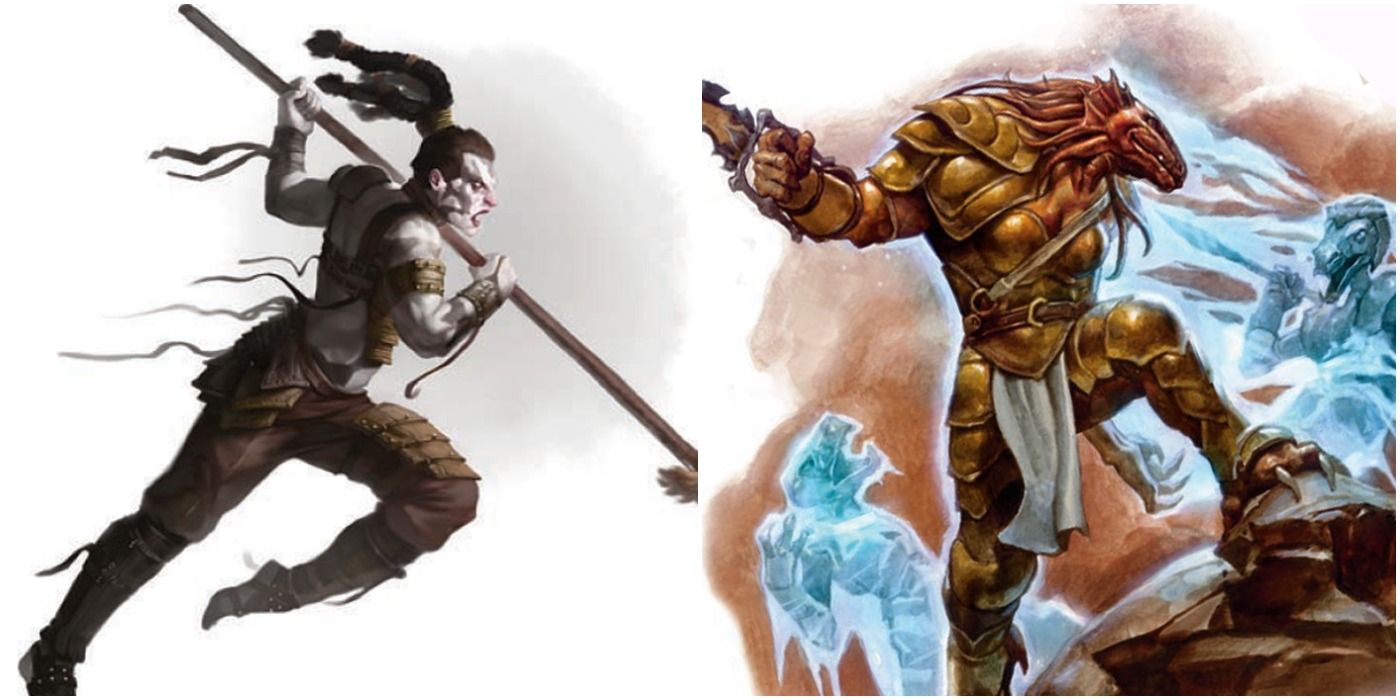
Dungeons & Dragons: 15 Subclasses From Previous Editions That 5e Should Have
In previous editions, Dungeons and Dragons introduced some great subclass options. Here are some of the best deserving of a spot in 5e.
While this spell might not necessarily be useful all the time, it helps ward off unnecessary assassinations and poisons, especially to Faction NPCs. Most campaigns require players to attend some sort of banquet and gathering, and it's always a useful spell to use in the presence of kings, emperors, and those with positions of power.
When To Use Purify Food and Drink
While not beneficial in combat, politically-heavy campaigns in Dungeons & Dragons could use the occasional poison check. Using Purify Food and Drink on food provided by guests can be a surefire way of avoiding harmful substances and even ingredients that may cause paralysis and sleeping, which are sometimes ways DMs use to split parties.
15 Virtue
Abjuration Cantrip
| Casting Time | 1 Action |
|---|---|
| Range | Touch |
| Target | A creature |
| Components | Verbal, Somatic |
| Duration | 1 Round |
| Classes | Cleric |
Although included in Unearthed Arcana: Starter Spells, spellcasters who can use Virtue may have access to saving grace in the gravest of situations in both tabletop and video games like Baldur's Gate 3. When cast with Verbal and Somatic Components, the Abjuration Cantrip affects a creature the Cleric can touch. This effect provides vitality to the target, gaining 1d4 + Spellcasting Modifier Temporary Hit Points as long as they still have at least 1 Hit Point left.
The main caveat of Virtue is how the Temporary Hit Points only last for a round, requiring them to either cast the Spell again or hope the target can make the most out of their Hail Mary. Despite only granting Temporary Hit Points, a healing-based Cantrip in a D&D experience can make more difference than a damaging one in dangerous fights.
14 Bless
1st-Level Enchantment
| Casting Time | 1 Action |
|---|---|
| Range | 30 Feet |
| Target | Up to three creatures |
| Components | Verbal, Somatic, Material (holy water) |
| Duration | Concentration (1 Minute) |
| Classes | Cleric, Paladin |
Perhaps a staple spell in any Cleric and Paladin’s arsenal, Bless can distinguish between a successful task and a colossal failure. When cast with Verba, Somatic, and Material (holy water) Components, this Enchantment Spell can affect up to three creatures within a 30-foot range. Throughout the Spell’s one-minute duration, Saves and Attack Rolls made by the blessed targets will get a 1d4 bonus.
Despite the mere 1d4 buff, players of Dungeons & Dragons need to remember that even single-number differences can affect the success or failure of a roll. Spellcasters may want to use Bless to boost the odds of party members who need to use their lower-numbered stats to make checks, such as the frail Wizard having to make an Athletics (STR) check to jump from roof to roof during a chase.
13 Heat Metal
2nd-Level Transmutation
| Casting Time | 1 Action |
|---|---|
| Range | 60 Feet |
| Target | A manufactured metal object within range |
| Components | Verbal, Somatic, Material (piece of iron, flame) |
| Duration | Concentration (1 Minute) |
| Classes | Artificer, Bard, Druid |
At first glance, Heat Metal seems vague for a 2nd-Level Transmutation Spell. When cast with Verbal, Somatic, and certain Materials (an iron piece and a flame), heating another piece of metal doesn’t seem worthwhile. However, what makes Heat Metal quite dangerous is its implications, even if it's not the usual damaging Evocation Spell. Should any creature make contact with the heated metallic item, they immediately take 2d8 Fire Damage at the onset. This damage can be triggered as a Bonus Action throughout the spell’s one-minute duration.
Should the metallic object be held, the creature holding it must also succeed in a CON Save or risk dropping it. If they don’t drop the item, they have Disadvantage on Ability Checks and Attack Rolls until the caster’s next turn begins. These effects make Heat Metal quite the effective deterrent against hulking tanks in plate armor, or even a dextrous fighter relying on their weapons.
12 Shape Water
Transmutation Cantrip
| Casting Time | 1 Action |
|---|---|
| Range | 30 Feet |
| Target | An area within range that fits a 5-foot cube |
| Components | Somatic |
| Duration | Instantaneous (1 Hour) |
| Classes | Druid, Sorcerer, Wizard |
When players think of spells, they think of damaging fireballs and chilling rays. However, Shape Water from Xanathar’s Guide to Everything serves as one of the most useful Spells in the entire Edition. Spellcasters can use Shape Water within a 30-foot range with only Somatic components. It allows them to manipulate an area of water that fits within a 5-foot cube. They can move or freeze water, change its opacity and color, or even animate it.
Things that spellcasters create or manipulate with Shape Water can last up to an hour. Despite the Spell’s simple nature, its effects can have major implications. For instance, players can freeze water into walls to block enemies, freeze puddles to create a step-by-step bridge, or even hide messages in puddles of water.
When To Use Shape Water
Arguably one of the most versatile Spells that manipulate the natural elements, Shape Water is as flexible as Prestidigitation should players know how to use it properly. Common uses of Shape Water include blocking hallways, building a bridge of 5-foot ice segments, and even dropping a giant ice cube on a target. Knowing water physics can lead to more unique uses, such as inserting water into a lock and freezing it to break it from the inside.
11 Alarm
1st-Level Abjuration
| Casting Time | 1 Minute |
|---|---|
| Range | 30 Feet |
| Target | 20-foot cube |
| Components | Verbal, Somatic, Material (silver wire, tiny bell) |
| Duration | 8 Hours |
| Classes | Artificer, Range, Wizard |
For fast-paced encounters, it seems the Alarm doesn’t boast a lot of benefits. The Spell affects an area of a 20-foot cube for as long as eight hours. What good would Alarm’s effect do if the battle is already underway? In a world where only the paranoid survive, Alarm is a gift from the gods.
To use Alarm effectively, spellcasters should never prepare this spell. Rather, they should acquire Alarm as a Ritual as soon as possible. That way, players can cast Alarm as a Ritual prior to long rests, ensuring the party they aren’t interrupted by enemies while asleep. Despite the mundane nature of this usage, a party can thank Alarm if they’re involved in a high-stakes campaign involving spies and treachery.
When To Use Alarm
While Alarm isn’t practical to use in combat, it makes for a decent precaution when in relatively unsafe spaces. Before resting, it’s ideal to cast Alarm as a Ritual and position it near the entrance of a camp or a room in order to alert the party of potential threats. This ensures adequate Long Rests for everyone in the party.


